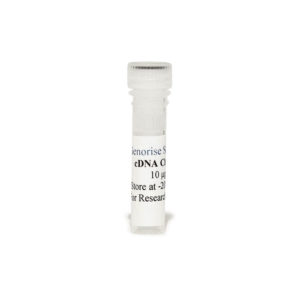Recombinant Human TLR5 Protein
$99.00 – $456.00
The recombinant human TLR5 protein is derived from in vitro expression of human TLR5 gene in E. coli and purified using his-tag affinity column and can be used in multiple applications such as cell culture, ELISA and western blot.
Alternative names for TLR5: Toll-like receptor 5
This product is for Laboratory Research Use Only not for diagnostic and therapeutic purposes or any other purposes.
- Description
- Product Citations
- Reviews (0)
Description
Genorise Recombinant Human TLR5 Protein Summary
Alternative names for TLR5: Toll-like receptor 5
Product Specifications
| Purity | > 96%, by SDSPAGE under reducing conditions and visualized by silver stain. |
| Endotoxin Level | < 0.1 EU per 1 μg of the protein by the LAL method. |
| Activity | na |
| Source | E. coli derived human TLR5. |
| Accession # | NP_003259.2 |
| N-Terminal Sequence Analysis | Ser |
| Amino Acid Sequence | Ser25-Cys583 |
| Predicted Molecular Mass | 61 kDa |
| SDS-PAGE | 61 kDa, reducing conditions |
Background:
Toll-like receptor 5 (TLR5) is a protein which is encoded by the TLR5 gene.[1] TLR5 is known to recognize bacterial flagellin from invading mobile bacteria. It has been shown to be involved in the onset of many diseases, which includes Inflammatory bowel disease.[2] Recent studies have also shown that malfunctioning of TLR5 is likely related to rheumatoid arthritis,[3] osteoclastogenesis, and bone loss.[4] Abnormal TLR5 functioning is related to the onset of gastric, cervical, endometrial and ovarian cancers.[5] TLR5 is expressed on both immune and non-immune cells. The activation of this receptor mobilizes the nuclear factor NF-κB and stimulates TNF alpha production. There are highly conserved regions in the flagellin protein among all bacteria, facilitating the recognition of flagellin by a germ-line encoded receptor such as TLR5.[6] However, some Proteobacteria flagella have acquired mutations preventing their recognition by TLR5.[7] The TLR5 signaling cascade is commonly triggered by the binding of bacterial flagellum to TLR5 on the cell surface. Binding of flagellum induces the dimerization of TLR5, which in turn recruits MyD88.[8] The recruitment of MyD88 leads to subsequent activation of IRAK4, IRAK1, TRAF6, and eventually IκB kinases.[9] Activation of IκB kinases contributes to the nuclear localization of NF-κB. NF-κB induces many downstream gene expressions, which initiates the canonical proinflammatory pathway. This TLR5/flagellum interaction results in different responses in different cell types. In epithelial cells, binding of flagellum to TLR5 induces IL8 production. In human monocytes and dendritic cells, this interaction results in the secretion of proinflammatory cytokines such as TNF. Recent study has identified Caveolin-1 as a potential regulator of TLR5 expression.[10] In contrast to the decreased TLR4 level in senescent cells, TLR5 expression maintains relatively stable during the aging process, which is correlated with the high level of Caveolin-1 in aging cells. Data from Caveolin-1 knockout mice demonstrated that TLR5 expression significantly decreases in the absence of Caveolin-1 expression in aging cells.[10] It is hypothesized that the Caveolin-1 directly interacts with TLR5 to stabilize it and hence increases the level of TLR5.
References
- Rock FL, et al. (1998). Proc Natl Acad Sci USA. 95 (2): 588–93.
- Stanislawowski M, et al. (2009). Journal of Physiology and Pharmacology. 60 Suppl 4: 71–5.
- Kim S, et al. (2014) J Immunol. 193(8):3902–13.
- Kassem A, et al. (2015). FASEB Journal. 29 (11): 4449–60.
- Husseinzadeh N, Davenport SM (2014). Gynecologic Oncology. 135 (2): 359–63.
- Smith KD, et al. (2003). Nature Immunology. 4 (12): 1247–53.
- Andersen-Nissen E, et al. (2005). Proc Natl Acad Sci USA. 102 (26): 9247–52.
- Gewirtz AT, et al. (2001). Journal of Immunology. 167 (4): 1882–5.
- Gohda J, et al. (2004). Journal of Immunology. 173 (5): 2913–7.
- Lim JS, et al. (2015). Molecules and Cells. 38 (12): 1111–7.
Product Citations
Be the first to review “Recombinant Human TLR5 Protein”
You must be logged in to post a review.


























Reviews
There are no reviews yet.